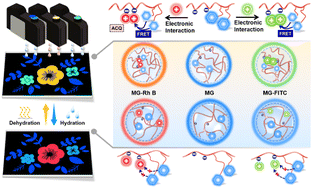The decryption and verification of encrypted information via a simple and efficient method is always difficult and challenging in the field of information security. Herein, a series of water-sensitive fluorescent microgels are fabricated for highly secured anti-counterfeiting with authenticity identification. The initial negatively charged microgels (MG) are made up of N-isopropylacrylamide (NIPAM), acrylic acid (AAc) and anthracen-9-yl acrylate (9-ANA, blue fluorescent monomer). The prepared MGs can bind cationic fluorescent dyes such as 5-aminofluorescein (FITC, green fluorescent dye) and rhodamine B (Rh B, red fluorescent dye) via electrostatic interaction, emitting multi-fluorescent colors based on the fluorescence resonance energy transfer (FRET) process. Furthermore, the fluorescence colors of MG-derived systems can be rapidly changed by swelling in water, which can block the FRET process and change the aggregation state of dyes. With the assistance of inkjet printing, multi-color security patterns can be designed and encoded, which can be revealed by UV irradiation and further verified by water stimulation. This study has pioneered a novel strategy to verify the authenticity of decrypted information, which greatly improves the security level of information.
